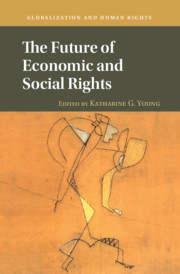Book contents
- The Future of Economic and Social Rights
- Globalization and Human Rights
- The Future of Economic and Social Rights
- Copyright page
- Contents
- Figures
- Tables
- Contributors
- Abbreviations
- Foreword
- Acknowledgements
- 1 Introduction
- Part I Adjudication and Rights
- Part II Adjudication and Rights in Context
- Part III Adjudication and Rights
- Part IV Economic and Social Rights in Retrenchment
- 11 The Future of Social Rights
- 12 The Present Limits and Future Potential of European Social Constitutionalism
- 13 Canada’s Confounding Experience with Health Rights Litigation and the Search for a Silver Lining
- 14 Universal Basic Income as a Social Rights–Based Antidote to Growing Economic Insecurity
- Part V Economic and Social Rights in Development
- Part VI Rights and Accountability
- Books in the Series
11 - The Future of Social Rights
Social Rights as Capstone
from Part IV - Economic and Social Rights in Retrenchment
Published online by Cambridge University Press: 04 April 2019
- The Future of Economic and Social Rights
- Globalization and Human Rights
- The Future of Economic and Social Rights
- Copyright page
- Contents
- Figures
- Tables
- Contributors
- Abbreviations
- Foreword
- Acknowledgements
- 1 Introduction
- Part I Adjudication and Rights
- Part II Adjudication and Rights in Context
- Part III Adjudication and Rights
- Part IV Economic and Social Rights in Retrenchment
- 11 The Future of Social Rights
- 12 The Present Limits and Future Potential of European Social Constitutionalism
- 13 Canada’s Confounding Experience with Health Rights Litigation and the Search for a Silver Lining
- 14 Universal Basic Income as a Social Rights–Based Antidote to Growing Economic Insecurity
- Part V Economic and Social Rights in Development
- Part VI Rights and Accountability
- Books in the Series
Summary
- Type
- Chapter
- Information
- The Future of Economic and Social Rights , pp. 289 - 323Publisher: Cambridge University PressPrint publication year: 2019

